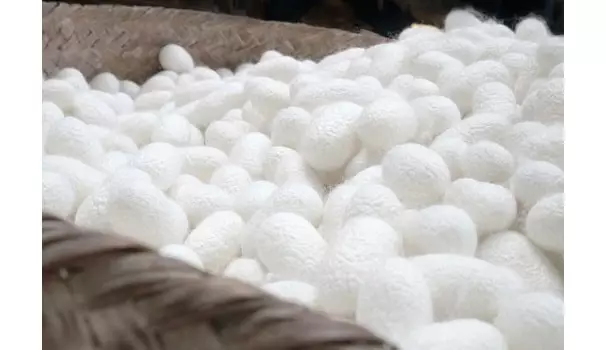Thousands of years ago, humans figured out how to extract fibres from caterpillars to make clothes. And now, after more than 5,000 years, humans are producing hundreds of thousands of metric tonnes of silk every year. How did we get this far? Well, the answer is pretty simple: humans have been producing this amount of silk by domesticating different silkworm species for thousands of years. It may surprise you that one single silkworm (Mulberry Species) can make a silk filament more than 1 kilometre in length. And just to produce 1 kilogramme of high-quality silk, more than 5000 silkworms are needed. Now you can get a firm idea of how large scale the silk production industry is.
When it comes to the top silk producers in the world, China is always at the top, but India isn’t far behind, ranking as the world’s second-largest silk producer. And India is the only country where you can expect to find the production of all five types of silk, such as Temperate Tasar, Tropical, Eri, Muga, Tasar, and Mulberry. The textile and apparel industries have a high demand for silk, and many Indian states participate in producing high-quality silk to meet this demand. Today we’ll be taking a look at some of the largest silk-producing states in India.
List of The Largest Silk Producing State In India
1. Karnataka
Situated in the south of Karnataka is the beautiful city of Mysore, where the majority of the silk is produced in the state. Karnataka produces more than 45% of India’s entire silk production, which is roughly around 9000 metric tons. Mysore silk is quite popular in the international markets, and it’s been popular since ancient times. You can find large production hubs as well as people harvesting silkworms to produce silk on smaller scales.
Mostly, mulberry silk is produced in Karnataka, and the quality remains world-class with every kilogramme of production. This sericulture in Karnataka is the primary source of income for thousands of families, and they’ve been harvesting silkworms for years. Silk production in Karnataka took off during the reign of Tipu Sultan in the Kingdom of Mysore from 1780 to 1790 A.D. When it comes to the current statistics of Karnataka’s silk production, it’s clear that it’s increasing by a few percentage points each year.
2. Andhra Pradesh
Andhra Pradesh is known for its rice and tobacco production, but it is also the second-largest silk-producing state in India. This state sits in the second spot with silk production of more than 5,500 tonnes per year. Among all of the produced silk in this state, 97% is raw Mulberry silk. Not only the production, but the weaving of silk is always going on a large scale in Andhra Pradesh. As a result, silk sarees and other apparel are popular not only in this state but in other Indian states as well. It’s a highly profitable business for harvesters and farmers, so many families in Andhra Pradesh are contributing to the second-largest silk production in India.
3. Assam
Assam is the second-largest tea and third-largest silk-producing state in India. The silk production is on average more than 5000 tonnes every single year. Muga and Eri silk are produced in higher quantities in Assam, which contributes to 95% of Muga and 65% of Eri of the entire nation’s silk production of these two types. Many families produce silk in Assam in the traditional way, and the technique is passed down to the next generation and so on. And now you know that, in addition to tea and breathtaking scenery, Assam is well-known for its silk production.
4. Tamil Nadu
Tamil Nadu is known for its incredible natural scenery and unique architectural temples. Along with that fact, Tamil Nadu is also the 4th largest raw silk-producing state in India with more than 1,200 tonnes of silk production every year. Since the developmental schemes started to introduce sericulture in various parts of Tamil Nadu, the increase in silk production has been significant in the last few decades. Mostly, the production hubs and local harvesters in Tamil Nadu produce only raw Mulberry silk and send it out for weaving and further processing.
5. Meghalaya
Meghalaya is known for its famous traditional festivals, monsoon, and breathtaking terrain, but its 5th highest silk production in India made us add it to our list. The amount of silk produced by Meghalaya is increasing year by year, and last year, Meghalaya alone produced nearly 1000 tonnes of silk. The government has empowered and come up with various schemes to increase silk production in the region. In recent years, many families and farmers have found it as an alternate source of income, which ultimately contributed to the increase in raw silk production in the country. Not only silkworm harvesting, but the weaving of produced silk is also popular in the region.
6. Jharkhand
Other than the rich mineral resources of Jharkhand, people also take part in harvesting silkworms and producing high-quality silk to export or sell. It sits in the 6th spot among the largest silk-producing states in India by adding more than 800 tonnes of silk to the total silk production of the nation. Slowly, it has become one of the best resources for making money for many families in the area where they extract silk from the silkworm using traditional methods or techniques. Jharkhand is known for its Tasar silk production to fulfil the demand for Tasar silk in the market.
These were the six largest silk-producing states in India, but there are others on the list following these six, such as Manipur, West Bengal, Maharashtra, Chhattisgarh, Nagaland, etc. Looking at the demand for high-quality silk in the world, it is possible that India surpasses China and becomes the largest silk-producing country in the world within a few decades or so. Since ancient times, Asia has been the world’s largest silk exporter; without silk, our history books would have read very differently. In India, we spend so much buying silk items of clothing, it is expensive but the best fabric one can ever imagine wearing.

Santosh Kumar is an editor at unfoldstuffs.com and a professional content writer. With years of experience he is passionate for creating engaging, informative and impactful topics.










